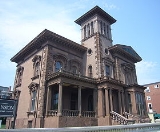
Victoria Mansion
Encyclopedia
Victoria Mansion, also known as the Morse-Libby House or Morse-Libby Mansion, is a landmark example of American residential architecture located in downtown Portland, Maine
, United States
. The brownstone
exterior, elaborate interior design, opulent furnishings and early technological conveniences provide a detailed portrait of lavish living in nineteenth-century America. It was declared a National Historic Landmark
in 1971.
, Boston
and New Orleans. The house was designed by the New Haven
architect Henry Austin
. Its distinctive asymmetric form includes a four-story tower, overhanging eaves, verandas, and ornate windows. Frescoes and trompe l’oeil wall decorations were created by the artist and decorator Giuseppe Guidicini.
The building is recognized as one of the finest and least-altered examples of a large Italianate Villa-styled brick and brownstone town house in the United States. Gustave Herter created the interiors in a range of styles; this house is his earliest known and only intact commission. More than ninety percent of the original contents survive, including Herter furniture, elaborate wall paintings, artworks, carpets, gas lighting fixtures, stained glass, porcelain, silver, and glassware. The house has twin sinks in the guest bedroom on the second floor, a Turkish smoking room, carved marble fireplaces and a flying staircase. Morse had features incorporated into the house familiar to him from his luxury hotels including the soaring entryway and wall-to-wall carpeting. In its supporting technology, the house was remarkably advanced for the time, with central heating, gas lighting, hot and cold running water, and a servant call system. The water was provided by gutters directing rain water into an enormous tank on the third floor.
Ruggles Morse died in 1893. In 1894, the house and its contents were sold to Joseph Ralph Libby, a Portland merchant. The Libby family occupied the house for over thirty more years, without making significant changes to it.
Portland, Maine
Portland is the largest city in Maine and is the county seat of Cumberland County. The 2010 city population was 66,194, growing 3 percent since the census of 2000...
, United States
United States
The United States of America is a federal constitutional republic comprising fifty states and a federal district...
. The brownstone
Brownstone
Brownstone is a brown Triassic or Jurassic sandstone which was once a popular building material. The term is also used in the United States to refer to a terraced house clad in this material.-Types:-Apostle Island brownstone:...
exterior, elaborate interior design, opulent furnishings and early technological conveniences provide a detailed portrait of lavish living in nineteenth-century America. It was declared a National Historic Landmark
National Historic Landmark
A National Historic Landmark is a building, site, structure, object, or district, that is officially recognized by the United States government for its historical significance...
in 1971.
House
This stately brownstone Italianate villa was completed in 1860 as a summer home for hotelier Ruggles Sylvester Morse. Morse had left Maine to make his fortune in hotels in New YorkNew York City
New York is the most populous city in the United States and the center of the New York Metropolitan Area, one of the most populous metropolitan areas in the world. New York exerts a significant impact upon global commerce, finance, media, art, fashion, research, technology, education, and...
, Boston
Boston
Boston is the capital of and largest city in Massachusetts, and is one of the oldest cities in the United States. The largest city in New England, Boston is regarded as the unofficial "Capital of New England" for its economic and cultural impact on the entire New England region. The city proper had...
and New Orleans. The house was designed by the New Haven
New Haven, Connecticut
New Haven is the second-largest city in Connecticut and the sixth-largest in New England. According to the 2010 Census, New Haven's population increased by 5.0% between 2000 and 2010, a rate higher than that of the State of Connecticut, and higher than that of the state's five largest cities, and...
architect Henry Austin
Henry Austin (architect)
Henry Austin was a prominent and prolific American architect based in New Haven, Connecticut. He practiced for more than fifty years and designed many public buildings and homes primarily in the New Haven area...
. Its distinctive asymmetric form includes a four-story tower, overhanging eaves, verandas, and ornate windows. Frescoes and trompe l’oeil wall decorations were created by the artist and decorator Giuseppe Guidicini.
The building is recognized as one of the finest and least-altered examples of a large Italianate Villa-styled brick and brownstone town house in the United States. Gustave Herter created the interiors in a range of styles; this house is his earliest known and only intact commission. More than ninety percent of the original contents survive, including Herter furniture, elaborate wall paintings, artworks, carpets, gas lighting fixtures, stained glass, porcelain, silver, and glassware. The house has twin sinks in the guest bedroom on the second floor, a Turkish smoking room, carved marble fireplaces and a flying staircase. Morse had features incorporated into the house familiar to him from his luxury hotels including the soaring entryway and wall-to-wall carpeting. In its supporting technology, the house was remarkably advanced for the time, with central heating, gas lighting, hot and cold running water, and a servant call system. The water was provided by gutters directing rain water into an enormous tank on the third floor.
Ruggles Morse died in 1893. In 1894, the house and its contents were sold to Joseph Ralph Libby, a Portland merchant. The Libby family occupied the house for over thirty more years, without making significant changes to it.

